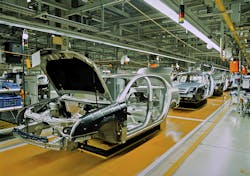Mixed Economic Indicators Point to Potential Slowdown in Industrial Market
As the June economic data starts to come in, Electrical Marketing’s editors are getting a pretty good idea of which way the economic winds are pushing the industrial market as it enters the second half of 2019.
It’s been said you can make the data say anything you want, and you can still find enough positive indicators to build a reasonably bullish forecast for the industrial market over the next few quarters. But more indicators are flashing warning signs about what looks like to be a gradual market slowdown. None are pointing to anything catastrophic, and it’s still hard to piece together enough of them to support the mild recession that some economists think could start by late 2020 or 2021.
...Some Reasons to Be Cheerful
You can still find a few rays of hope shining through what could be early storm clouds in the form of some key indicators calling for low single-digit year-over-year (YOY) growth. For example, manufacturing employment is still healthy, as the three-month moving average through May of 1.279 million employees is up 1.6% through the same period last year. And although the closely watched Purchasing Managers Index (PMI) published monthly by the Institute for Supply Management, Tempe, AZ, has declined over the past few quarters, it’s still clinging (barely) to growth territory at 51.7 points in June (anything under 50 points indicates that industrial purchasing managers say business conditions are declining). Closer to home, data on electrical manufacturers’ business activity through May was still showing some year-over-year growth, with electrical manufacturers’ shipments up +1.5% over May 2018 to $3,132 million, and new orders up just +0.5% to $3,108 million.
...And Now the Bad News
With its members super-skittish about the impact of tariffs, the latest Electrobusiness Conditions Index (EBCI) published by the National Electrical Manufacturers Association (NEMA), Rossyln, VA, showed that its indicators for current and future conditions are both in rough shape. The current conditions index plummeted 16 points in June to 34.4 points, well under the 50-point growth threshold. The future conditions segment of the index was even worse. Said the report, “For eight of the last 12 months, including the current period, the future conditions index has been under the growth threshold reading of 50. The June index value of 31.3, which marks a two-point decline from last month, is the lowest future component reading since Nov. 2008. Nearly 70% of this month’s respondents expect business conditions to be worse in six months. Virtually all comments point to public policy, especially those having to do with trade, as the main reason for the low expectations made evident in the numerical score.”
Other indicators focused on the broader industrial market weren’t as dismal as NEMA’s EBCI data, but still pointed toward lower growth ahead. Timothy Fiore, chair of the Institute for Supply Management said in the group’s June report that survey respondent sentiment was “evenly mixed.” “Comments from the panel (industrial purchasing managers) reflect continued expanding business strength, but at soft levels,” he said. “June was the third straight month with slowing PMI expansion. Demand expansion ended, with the New Orders Index recording zero expansion; the Customers’ Inventories Index remaining at a too-low level; and the Backlog of Orders Index contracting for the second straight month. New export orders remain weak… Respondents expressed concern about U.S.-China trade turbulence, potential Mexico trade actions and the global economy.”
Data from the Association of American Railroads (AAR), Washington, DC, on freight rail traffic also showed slower YOY growth. AAR’s weekly rail traffic data, which is considered a leading economic indicator because it reflects the amount of raw materials and finished goods shipped by rail, said for the first 28 weeks of 2019, total combined U.S. rail traffic (freight cars and intermodal units) was 14,452,846 carloads and intermodal units, a decrease of 3.3% compared to last year.
Machine-tool orders, a historically volatile measure of orders for metal cutting technologies for factories, are also underwater compared to last year. According to United States Manufacturing Technology Orders (USMTO) Report, “Despite the modest uptick in total orders from April, orders are down nearly -22% from May 2018, when orders totaled $484.2 million. The year-to-date total for 2019 increased to $1,867 million, a -13.5% decline from the 2018 total through May.”
Many Wall Street analysts consider industrial distributor Fastenal, Winona, MN, to be a bellwether for the industrial market because of its intense focus on serving manufacturing companies. The company’s stock price has grown through 2019 despite the dodgy industrial environment. There was plenty of discussion on the state of the industrial market in the company’s recent 2Q investment analysts teleconference. According to a transcript of that event, Holden Lewis, the company’s executive VP & CFO, told attendees, “From a macro standpoint, it’s clear that activity slowed. There’s no panic in the market, and the month-to-month cadence through the quarter was mostly steady, but sentiment has become more cautious.”
Indeed, caution seems to be the watchword for the industrial market as we move into 2019’s third quarter.
